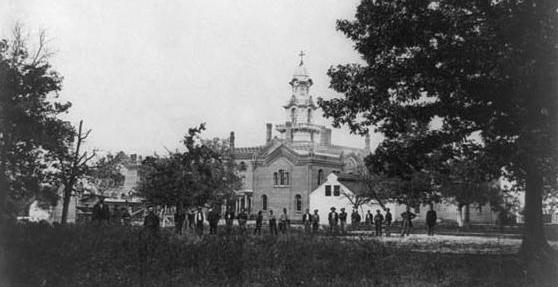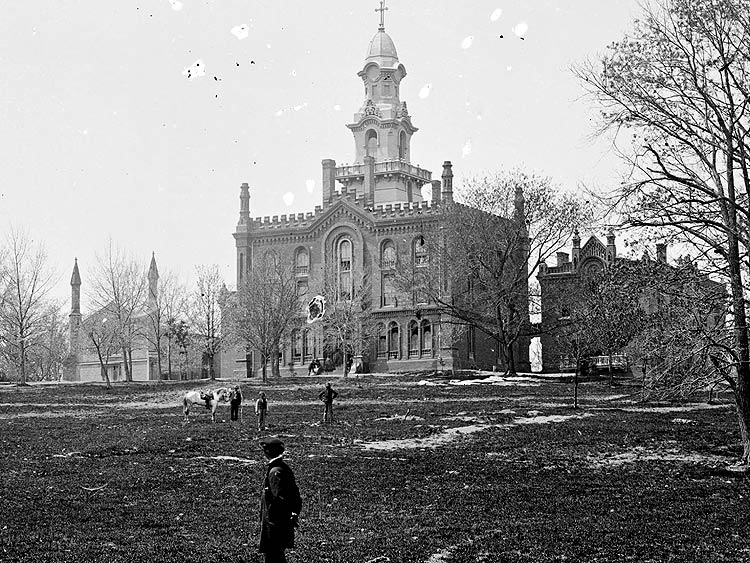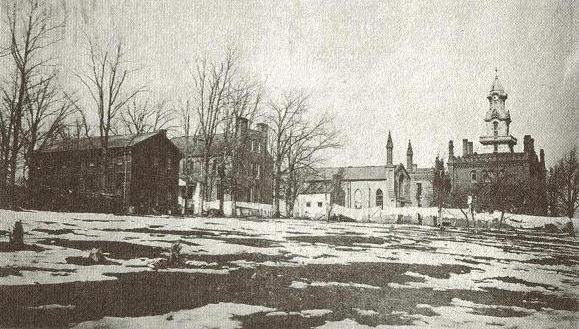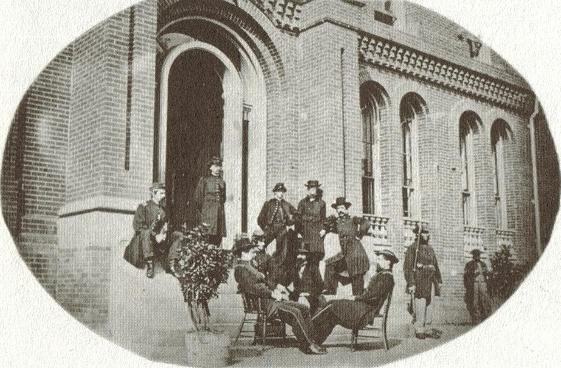DAVID HOWARD IN THE CIVIL WAR
Drawn Chiefly from His Military and Pension Records
![]() David Howard enlisted at Union Vale, N.Y., on Sept. 1, 1862 (by Capt. Benjamin S. Broas). At enlistment he was described as follows – Age: 47 years; Height: 5 feet, 10 inches; Complexion: dark; Eyes: hazel; Hair: dark; Where born: Dover, N.Y.; Occupation: farmer. His term of enlistment was for three years. Howard was designated to be a Private in Company I, 150th Regiment, New York Infantry, but on Sept. 18 – before his company had been mustered into federal service – he deserted from Camp Dutchess in Poughkeepsie, N.Y. (where the regiment was then training). In 1884 Howard recounted:
David Howard enlisted at Union Vale, N.Y., on Sept. 1, 1862 (by Capt. Benjamin S. Broas). At enlistment he was described as follows – Age: 47 years; Height: 5 feet, 10 inches; Complexion: dark; Eyes: hazel; Hair: dark; Where born: Dover, N.Y.; Occupation: farmer. His term of enlistment was for three years. Howard was designated to be a Private in Company I, 150th Regiment, New York Infantry, but on Sept. 18 – before his company had been mustered into federal service – he deserted from Camp Dutchess in Poughkeepsie, N.Y. (where the regiment was then training). In 1884 Howard recounted:
I had a wife & 5 children & left them & volunteered & went in the army to help save the country. My wife & 3 children died while I was in the army.
Howard’s desertion may have had something to do with these deaths (if they occurred soon after his enlistment), or with the illnesses that led up to them. (Howard’s comments regarding his “wife” at this point in his life are a bit strange, in view of the fact that at the time of his enlistment he had been divorced for nine years.) In any case, he rejoined his company and regiment at Camp Belger (or Belger Barracks) in Baltimore, Md., on Jan. 31, 1863 (by order of Maj. Van Vliet in New York), and no punitive measures were taken against him. David Howard’s brother Silas served with him in Company I. Seneca Humiston, who was a First Sergeant and later a Second Lieutenant in the Howard brothers’ company, recalled in 1884 that “Those boys were both good soldiers & always ready for duty.”
![]() David Howard remained in Baltimore until June 25, when the regiment left that city to join the main body of the Army of the Potomac. He participated with his regiment in the last two days of the battle of Gettysburg, Pa., on July 2 and 3, 1863, and in the pursuit of the Army of Northern Virginia after the battle, beginning on July 5. At Williamsport, Md., on July 12, while helping to throw up breastworks, Howard suffered a scrotal hernia, which incapacitated him, leading eventually to his discharge from the army.
David Howard remained in Baltimore until June 25, when the regiment left that city to join the main body of the Army of the Potomac. He participated with his regiment in the last two days of the battle of Gettysburg, Pa., on July 2 and 3, 1863, and in the pursuit of the Army of Northern Virginia after the battle, beginning on July 5. At Williamsport, Md., on July 12, while helping to throw up breastworks, Howard suffered a scrotal hernia, which incapacitated him, leading eventually to his discharge from the army.
![]() In 1884 Howard summarized his military service from enlistment to discharge in the following words:
In 1884 Howard summarized his military service from enlistment to discharge in the following words:
I enlisted Sept. 10th [sic], 1862. We went into camp at Po’keepsie & staid till the latter part of Oct. if I remember right. We just drilled there. We went from Po’keepsie to Baltimore & encamped for the winter at Camp Belcher. We guarded the city and drilled while there. On the 11th [sic] of June ‘63 we left Baltimore & went to a point about 30 miles south east of Washington & joined Mead’s forces at Banoxie(?) Bridge [Monocacy Bridge] & went on to Gettysburg. We marched on steadily & got at Gettysburg I think the last day of June [sic]. We took part in the three [sic] days fight, the 1st [sic], 2d & 3d day of July. I was in the fight faithfully till it was over with. ... On the 4th or 5th day of July we started on a forced march to catch Lee. We kept right after him till we got to Williamsport, Pa. [sic] At that place we came in [to the] right of Lee & commenced to put up breast works as we expected a big battle. It was there that I got hurt. We was rolling up big logs & heavy stones & I over-lifted – one of my feet slipped & busted me open [and] crippled me. That was about the 8th or 10th [sic] of July ‘63. I give up work right away. I marched on then & rode till we got to Warrenton Junction – I didn’t ride much before I got to Warrenton Junction – then I went with the company – marching & riding in the wagons till we got to Kelly’s Ford. That was the last of July or first [of] August. ... We lay at Kelly’s Ford 3 or 4 days & I staid with the company & the surgeon, Dr. Campbell, sent me to Fair Fax Seminary Hospital. He saw that I wasn’t able to stand the pressure any more. I was there in that hospital about 3 months before I could do anything at all except walk around a little with canes. I had this here rupture while I was there. I didn’t have anything else while I was there much except the dysenterry pretty bad but I got over that. After I’d been there a while they made me an attendant on the others & after I’d stood that as long as I could they discharged me & sent me home. I was discharged Oct 18th [sic], 1864. I came right home from the hospital to my brother’s at Chestnut Ridge – my brother Silas. He was in my company & came home about a month ahead of me.
In elaborating on the construction of the breastworks at Williamsport, Howard noted that “it was done mostly in the night.” And in elaborating on the injury that he suffered on that occasion, and on the events that followed this, he added:
One of my feet slipped while I was helping roll a big oak log – I was lifting as hard as I could & the wrench hurt me. I felt a pain on the left side at first – a sharp, knife pain as if a knife was stuck in me. It made me holler right out. ... I was swelled all up & in such misery that it seemed as if I should die. There was a bunch as big as a goose egg – it came right down into my bag & kept getting bigger & bigger till we got to Kelly’s Ford. Down by Warrenton Junction it got down on both sides. When I got to Kelly’s Ford the left side was as large as a big goose egg & the right side was as big as a common goose egg. ... On that march I had by spells to hold it up with one hand. We was on a forced march... Near Banoxie [Monocacy] is where the right side first give out.
William Hall, who had been a member of Howard’s company, also recalled in 1884 that Howard “was sick at Kelly’s Ford & was sent back [to the] hospital.” According to Hall, during the time when the regiment was at Kelly’s Ford, Howard “laid around camp 3 or 4 weeks before he was sent off.”
![]() Howard was sent to the Fairfax Seminary U.S.A. General Hospital in Alexandria, Va., on Aug. 5, 1863. Hospital records indicate that he was treated there for acute diarrhoea, beginning on Aug. 6; for varicocele, beginning on Dec. 22, 1863; and for a left inguinal hernia, beginning on Sept. 11, 1864. Also, while at the hospital, Howard was transferred, on Mar. 5, 1864, to the 81st Company, 2nd Battalion, United States Veteran Reserve Corps (originally known as Company K, 19th Regiment, V.R.C.), commanded by Capt. Clinton Spencer. This transfer was “by reason of loss of so many teeth that proper mastication of food is impossible; prematurely aged (49 years).” In 1884 Howard himself noted: “I belonged to the V.R.C. & was detailed for service in that same hospital.” Finally, on Oct. 17, 1864, at the Fairfax Seminary Hospital, Howard was “Discharged by his own request,” for disability.
Howard was sent to the Fairfax Seminary U.S.A. General Hospital in Alexandria, Va., on Aug. 5, 1863. Hospital records indicate that he was treated there for acute diarrhoea, beginning on Aug. 6; for varicocele, beginning on Dec. 22, 1863; and for a left inguinal hernia, beginning on Sept. 11, 1864. Also, while at the hospital, Howard was transferred, on Mar. 5, 1864, to the 81st Company, 2nd Battalion, United States Veteran Reserve Corps (originally known as Company K, 19th Regiment, V.R.C.), commanded by Capt. Clinton Spencer. This transfer was “by reason of loss of so many teeth that proper mastication of food is impossible; prematurely aged (49 years).” In 1884 Howard himself noted: “I belonged to the V.R.C. & was detailed for service in that same hospital.” Finally, on Oct. 17, 1864, at the Fairfax Seminary Hospital, Howard was “Discharged by his own request,” for disability.
![]() In 1884, A. I. Bush, a Special Examiner of the Pension Office, investigated the claims for disability pensions that had been filed by David Howard and by his brother Silas. (Silas had been transferred to the Veteran Reserve Corps on Mar. 23, 1863, and had been discharged for disability on Sept. 19, 1864.) Bush took depositions from the Howard brothers, as well as from many others who had known David and Silas before, during, and after the war. Among those he interviewed was Dr. Cornelius N. Campbell, who had been the examining surgeon for the recruits for the 150th N.Y. Infantry. At the conclusion of this process Bush recommended that the brothers be pensioned because of their disabilities, but he also opined that
In 1884, A. I. Bush, a Special Examiner of the Pension Office, investigated the claims for disability pensions that had been filed by David Howard and by his brother Silas. (Silas had been transferred to the Veteran Reserve Corps on Mar. 23, 1863, and had been discharged for disability on Sept. 19, 1864.) Bush took depositions from the Howard brothers, as well as from many others who had known David and Silas before, during, and after the war. Among those he interviewed was Dr. Cornelius N. Campbell, who had been the examining surgeon for the recruits for the 150th N.Y. Infantry. At the conclusion of this process Bush recommended that the brothers be pensioned because of their disabilities, but he also opined that
these men entered the service at a time of life & in a physical condition when & in which an early break down of their constitutions was a natural result. They had passed the prime of life, had been hard-working and hard-drinking men, & the first real service that they saw, the Gettysburg Campaign, carried them to the hospital. They probably should have been rejected by Dr. Campbell...






